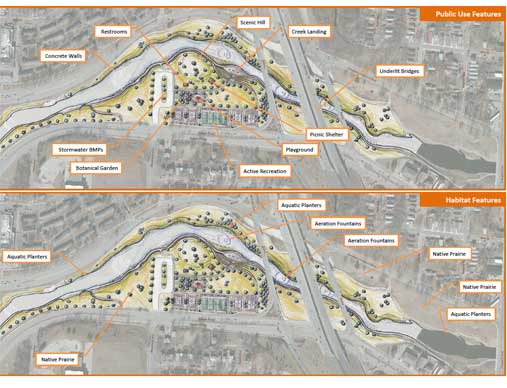
You have a chance to comment at a workshop today on three different ideas like this one for improving Brush Creek from Prospect to The Paseo. Suggestions from the public have ranged from leaving the area alone to serve as a wetland…to building a mini-zoo, botanical garden or outdoor stage…to developing trails and areas for football, soccer or basketball.
Ever since floods in the 1970s, Kansas City has been working on flood mitigation and other improvements along Brush Creek. Today attention shifts to what’s called the Bruce R. Watkins Reach of the creek – the area from the Prospect Bridge to The Paseo. Residents of the area are invited to view three alternative plans and offer input that will help shape the creek’s future.
The Bruce R. Watkins Reach
Carol Grimaldi of Brush Creek Community Partners says it’s a chance to drill down into the Bruce R. Watkins Reach — 2,100 feet of stream — and consider a wide array of ecosystem restoration measures, flood risk management, recreational options and water quality improvements. The area contains the largest piece of parkland along Brush Creek and also offers opportunities for habitat restoration.
“The community will be looking at alternatives that have been developed through meetings I’ve had with neighborhood groups,” Grimaldi says. “Once we agree upon the best alternative, we can move ahead to a final plan.”
The three alternatives include:
- Alternative 1: concrete channel walls similar to upstream and downstream reaches; aeration by means of fountains; more formal park
- Alternative 2: natural bluffs; riffles and pools; more active recreation
- Alternative 3: natural banks; riffles and pools; wetland benches; more natural park
An overarching plan for Brush Creek
For decades, hundreds of millions of dollars of public investment have gone into Brush Creek for flood risk management, bridge replacement and infrastructure water quality improvements on both sides of the state line.
The “big picture” goal, Grimaldi explains, is the development of a Brush Creek Watershed Management Plan. This work is being led by the Brush Creek Coordinating Committee through collaboration and sponsorship of Kansas City, Missouri; Johnson County, Kansas; and the U.S. Army Corps of Engineers.
“It’s challenging because no one has overarching authority over flood risk mitigation on Brush Creek,” she says. “It’s a 29-mile watershed that runs through two states and 13 municipalities. When one community fixes a problem, it can cause another problem downstream.”
The initial phase of the Bi-State Brush Creek Basin Study focused on the Bi-State Reach from Roanoke Parkway west, just into Johnson County. Planning is being finalized for this reach; alternatives for it can be examined at www.brushcreekwatershed.com, click on “Projects,” and then “Bi-State Reach.” Other areas of the Brush Creek Watershed will be examined in later stages of the study.
The public workshop will be held tonight from 5 to 7 p.m. at the Anita B. Gorman Conservation Discovery Center, 4750 Troost Avenue, Kansas City, MO.
The alternatives can be viewed at www.brushcreekwatershed.com.



Who’s talking